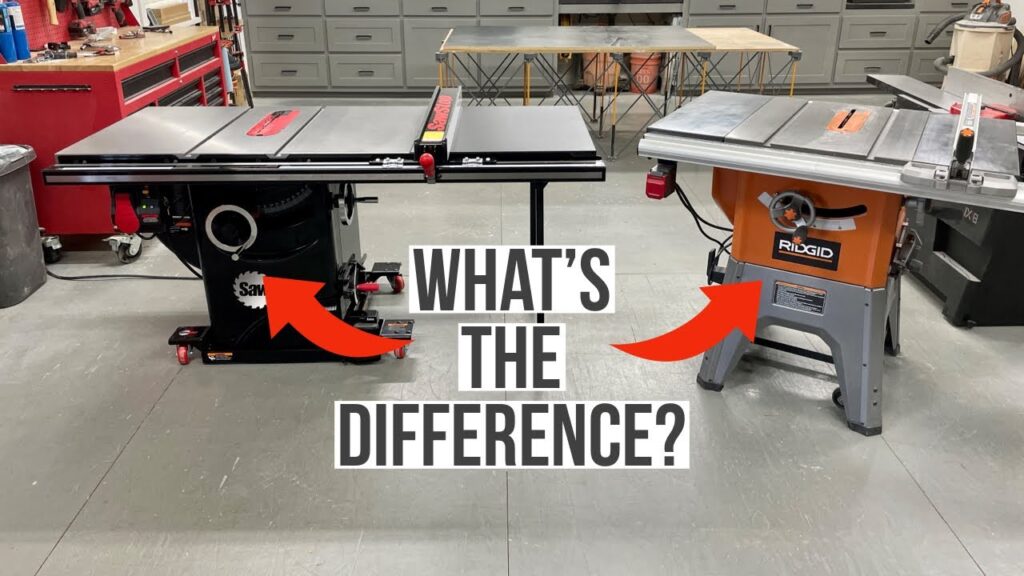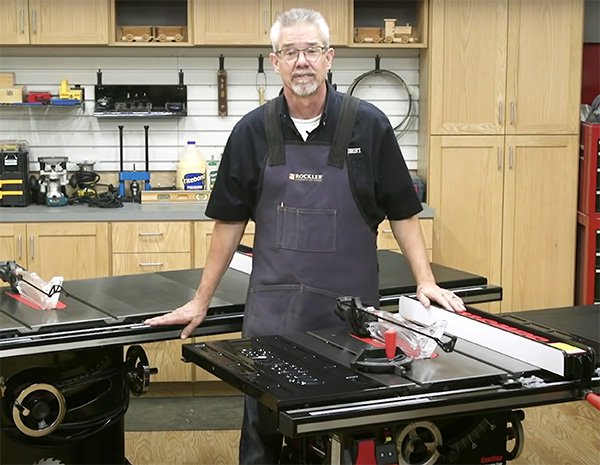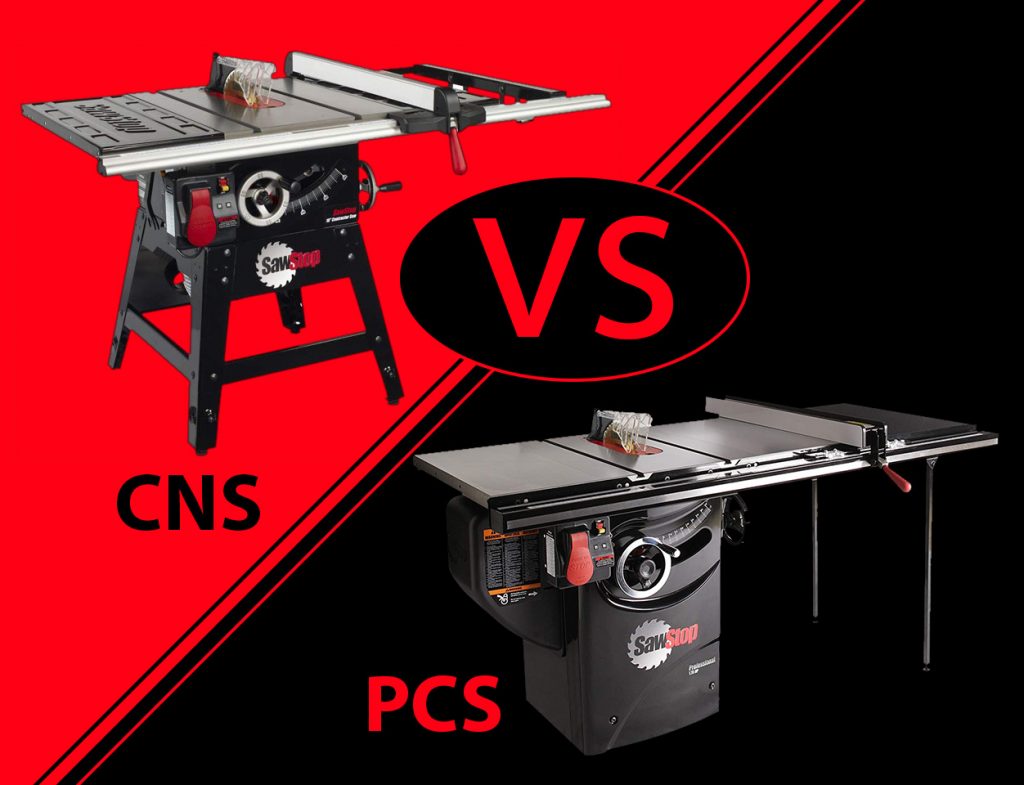If you’ve ever found yourself pondering over the distinction between a contractor table saw and a cabinet table saw, look no further. This article will shed light on the key differences between these two types of saws, helping you make an informed decision when it comes to purchasing the right one for your woodworking needs. Whether you’re a professional carpenter or a DIY enthusiast, understanding the nuances of these table saws is crucial for achieving accurate and efficient cuts. So, let’s jump in and explore the disparities that set these two powerhouses apart.

This image is property of i.ytimg.com.
Design
Build and Size
When it comes to design, the build and size of a table saw are critical factors to consider. A contractor table saw is typically built with a smaller and more portable design compared to a cabinet table saw. The smaller size of a contractor table saw makes it easier to move around and transport to different job sites. On the other hand, a cabinet table saw is larger and heavier, designed to stay in a fixed location. This difference in build and size lends itself to different uses and work environments.
Portability
Portability is often a key consideration for users who need to move their table saws between job sites or workshops. Contractor table saws are designed with portability in mind. They are usually equipped with folding stands, wheels, or collapsible features that make them easy to transport. In contrast, cabinet table saws are heavier and larger, making them less suitable for frequent transportation. While they may not be as portable, cabinet table saws are generally more stable and offer a sturdy work surface.
Power and Performance
Motor Power
The power of a table saw’s motor is crucial in determining its performance and capabilities. Contractor table saws typically have smaller motors, ranging from 1 to 2 horsepower (HP). These motors are suitable for most basic cutting tasks and are often more than enough for hobbyists or DIY users. Cabinet table saws, on the other hand, boast larger and more powerful motors, ranging from 3 to 5 HP. The increased motor power allows cabinet table saws to handle larger and tougher materials with ease, making them ideal for professional workshops or construction sites.
Cutting Depth and Capacity
The cutting depth and capacity of a table saw play a significant role in its versatility and usefulness. Contractor table saws usually offer a cutting depth of around 3 inches, which is sufficient for most woodworking projects. However, cabinet table saws excel in this area, with cutting depths of up to 4 or 5 inches. Additionally, cabinet table saws often have longer rip capacities, allowing for wider cuts and improved efficiency. This increased cutting depth and capacity make cabinet table saws a top choice for professionals who work with large or thick materials.
Accuracy and Precision
Whether you’re a professional woodworker or a DIY enthusiast, accuracy and precision are fundamental when using a table saw. Contractor table saws often provide satisfactory accuracy, but cabinet table saws take it to the next level. With their heavier build and more robust construction, cabinet table saws offer improved stability and reduced vibration, resulting in cleaner and more precise cuts. This enhanced accuracy is crucial for tasks that require fine detail or when working with expensive materials.
Stability and Vibration
Table saw stability and vibration control are important factors that impact both the quality of cuts and the safety of the user. Contractor table saws, being smaller and lighter, are more prone to vibrations. This can affect the accuracy of cuts and potentially result in less desirable outcomes. Cabinet table saws, on the other hand, are designed to minimize vibrations through their heavier and more stable construction. This stability and reduced vibration make cabinet table saws more reliable and safer to work with, especially when handling larger or heavier materials.
Price
Initial Cost
The initial cost is often a significant consideration for users when deciding which table saw to purchase. Contractor table saws tend to be more budget-friendly compared to cabinet table saws. They offer a more affordable option for hobbyists, DIY users, or those just starting in woodworking. Cabinet table saws, on the other hand, come with a higher price tag due to their larger size, more powerful motors, and advanced features. These saws are often the choice of professionals who require top-notch performance and durability.
Maintenance and Repairs
In addition to the initial cost, it’s important to consider the long-term maintenance and repair expenses. Contractor table saws are generally easier to maintain and repair. Their simpler design and construction make it easier to troubleshoot and replace parts if necessary. Cabinet table saws, although more robust, may require more specialized maintenance and repairs. However, these saws are often built to withstand heavy usage, which can reduce the need for frequent repairs and replacement parts.
Safety Features
Blade Guard
Safety is paramount when working with any power tool, and a table saw is no exception. A blade guard is a crucial safety feature that helps protect the user from accidental contact with the spinning blade. Both contractor and cabinet table saws come with some form of blade guard. However, cabinet table saws typically have more advanced blade guard systems, offering better visibility and ease of use. This ensures that the user can work safely without compromising on the visibility of the cutting area.
Anti-Kickback Pawls
Anti-kickback pawls are another key safety feature found in both contractor and cabinet table saws. These pawls prevent the workpiece from being forcefully thrown back towards the user, reducing the risk of injury. While both types of table saws come equipped with anti-kickback pawls, cabinet table saws often have more advanced systems that provide added protection. These enhanced safety features make cabinet table saws an attractive option, particularly for users who prioritize safety.
Riving Knife
A riving knife is an essential safety feature that prevents the wood from pinching or binding against the back of the blade. This helps reduce the chance of kickback and promotes safer cutting. While both contractor and cabinet table saws generally come with riving knives, the design and adjustability of the knife may differ. Cabinet table saws often have more refined riving knife systems that allow for quick adjustments, ensuring optimal safety and performance.
Dust Collection System
Dust control is not only crucial for maintaining a clean workspace but also for protecting the user’s health. Both contractor and cabinet table saws typically come with some form of dust collection system. However, cabinet table saws often have more advanced and efficient dust collection systems. These systems are designed to capture and contain a higher volume of dust, keeping the work area cleaner and reducing the risk of respiratory issues. An effective dust collection system is a valuable feature, particularly for those working in small or enclosed spaces.

This image is property of www.protoolreviews.com.
Versatility and Cutting Options
Fence and Miter Gauge System
The fence and miter gauge system are essential components that determine the precision and versatility of a table saw. Both contractor and cabinet table saws come with fence and miter gauge systems, but the quality and functionality may differ. Cabinet table saws generally have more robust and accurate fence systems, allowing for precise and consistent cuts. The miter gauge system on cabinet table saws is often more advanced, offering better angles and adjustable stops for improved accuracy. These enhanced systems make cabinet table saws more versatile and suitable for complex woodworking projects.
Ability to Handle Different Materials
The ability to handle various materials is crucial when choosing a table saw. Contractor table saws can handle most common types of wood and lighter materials, making them suitable for general woodworking tasks. Cabinet table saws, on the other hand, excel in this area. With their more powerful motors and larger cutting capacities, cabinet table saws can effortlessly tackle dense hardwoods, thick boards, and even non-wood materials like metals or plastics. If you work with a wide range of materials, a cabinet table saw can offer the versatility and power you need.
Specialized Cutting Features
Specialized cutting features are often built into table saws to cater to specific needs or preferences. Both contractor and cabinet table saws may offer additional features such as bevel cutting or dado stack compatibility. However, cabinet table saws tend to have more specialized cutting features due to their higher price range and performance capabilities. These additional features can include sliding tables, scoring blades, or even CNC compatibility. If you require advanced cutting options, a cabinet table saw may be the better choice to meet your specific needs.
Ease of Use and Accessibility
Tabletop Surface
The tabletop surface plays a significant role in the overall usability and convenience of a table saw. Both contractor and cabinet table saws typically have flat and smooth tabletop surfaces. However, cabinet table saws often have larger and more spacious tables, providing more area for workpieces and better support. This additional space can be particularly beneficial when working with larger or longer materials. Additionally, cabinet table saws may offer extension tables or additional work surface attachments, further enhancing the convenience and ease of use.
Blade Adjustment
The ease of adjusting the blade height and bevel angle is an important factor to consider for users who frequently switch between different cutting tasks. Contractor table saws often have more simple and straightforward blade adjustment mechanisms, making it easy for users to make quick changes. Cabinet table saws, on the other hand, may have more sophisticated and precise blade adjustment systems, allowing for precise increments and fine-tuning. This enhanced blade adjustment capability can be advantageous for users who prioritize accuracy and efficiency.
Tool Storage and Accessories
Table saw accessories and tool storage options can greatly improve the overall user experience and workflow. Both contractor and cabinet table saws offer various accessory options, such as dado inserts, blade guards, or push sticks. However, cabinet table saws typically have more built-in storage space or integrated tool storage features. These convenient storage compartments allow users to keep their essential tools and accessories within reach, saving time and increasing productivity. If having organized tool storage is important to you, a cabinet table saw may be the preferred choice.
Ease of Assembly
The ease of assembly is an important consideration for users who prefer to set up their equipment quickly and efficiently. Contractor table saws are generally designed to be more straightforward to assemble, with fewer components and simpler instructions. This makes them a popular choice for DIY users or those who frequently move their saws between job sites. Cabinet table saws, due to their larger size and more complex design, may require more time and effort to assemble. However, the additional features and performance capabilities of cabinet table saws often make the assembly process worthwhile.

This image is property of www.protoolreviews.com.
Suitability for Different Work Environments
Professional Workshops
Professional workshops demand reliable and high-performance tools that can withstand heavy usage and deliver consistent results. Cabinet table saws are widely favored in professional workshops due to their superior power, stability, and precision. The larger cutting capacities and advanced features of cabinet table saws make them invaluable for professionals who require precise cuts, versatility, and durability.
Hobbyist or DIY Users
Hobbyists and DIY users often prioritize affordability, portability, and ease of use. Contractor table saws are ideal for these users, as they offer a balance between performance and cost. The smaller and more portable design of contractor table saws allows for easy transportation and storage, making them suitable for hobbyists or DIY users who may have limited space or frequently move their equipment.
Construction Sites
Table saws used on construction sites need to be durable, powerful, and capable of handling a wide range of materials. Cabinet table saws are often the preferred choice for construction sites due to their robustness and larger cutting capacities. They have the strength to handle demanding tasks, such as cutting thick boards or dense materials, making them essential tools for contractors and construction professionals.
Noise and Dust
Noise Level
Noise control is important for both user comfort and compliance with workplace regulations. Contractor table saws generally produce less noise compared to cabinet table saws. This is due to their smaller motors and overall size. While both types of table saws can create noise during operation, contractor table saws are typically more suitable for environments where noise levels need to be minimized, such as residential settings or shared workshops.
Dust Control and Collection
Dust control is crucial for maintaining a clean and healthy work environment. Both contractor and cabinet table saws offer some form of dust control and collection. However, cabinet table saws often excel in this area. With their more advanced dust collection systems, cabinet table saws can efficiently capture and contain a higher volume of sawdust. This is especially beneficial for woodworkers who work in smaller or enclosed spaces, as it helps reduce the risk of respiratory issues and keeps the workspace cleaner.

This image is property of www.rockler.com.
Brand and Model Options
Popular Brands
When it comes to table saws, there are several popular brands known for their quality and reliability. Some of the renowned brands in the market include DeWalt, Bosch, Makita, SawStop, and Powermatic. These brands have a reputation for producing high-quality table saws with a range of features and options to suit different user preferences and requirements.
Specific Models
Within each brand, there are specific models that stand out for their performance and features. For example, DeWalt’s DWE7491RS and Bosch’s 4100-09 are highly regarded contractor table saw models, offering portability, power, and precision. For cabinet table saws, SawStop’s PCS31230-TGP236 and Powermatic’s PM1000 are popular choices among professionals, boasting impressive performance, safety features, and durability.
Conclusion
In conclusion, choosing between a contractor table saw and a cabinet table saw depends on the user’s specific needs, preferences, and work environment. Contractor table saws are generally more affordable, portable, and suitable for hobbyists or users who move their equipment frequently. On the other hand, cabinet table saws offer superior power, cutting capabilities, stability, and safety features, making them ideal for professional workshops or construction sites. Consider factors such as motor power, cutting depth, safety features, ease of use, and the ability to handle different materials when making your decision. Ultimately, choosing a reliable brand and the right model will ensure that you have a table saw that meets your requirements and helps you achieve outstanding results in your woodworking projects.

This image is property of www.trentdavis.net.
